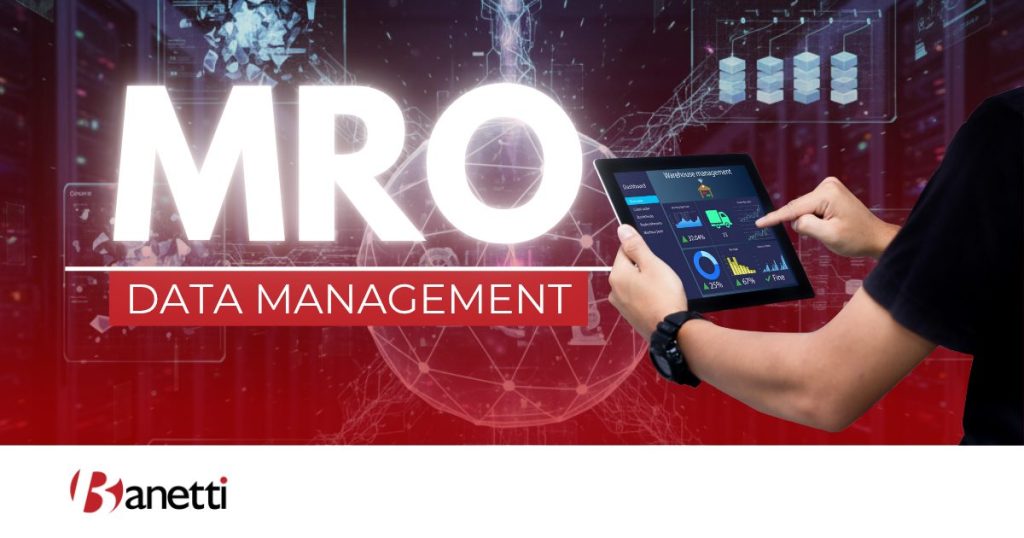5 Min Read
Table of contents

Today, MRO data management has become the cornerstone of operational excellence. Managing maintenance, repair, and operations (MRO) data efficiently helps asset-intensive organizations reduce inventory costs, minimize downtime, and support predictive maintenance.
Clean, accurate, and well-governed MRO master data provides a unified foundation for inventory management, procurement, and maintenance planning. Without it, organizations struggle with duplicate entries, obsolete parts, and disparate systems, issues that compromise data quality, inflate costs, and erode decision-making confidence.
This article explores how a structured approach to master data management (MDM) in the MRO domain enhances operational efficiency, supports digital transformation, and helps achieve cost control across supply chain management and plant operations.
What Is MRO Data Management?

To understand the value of MRO data management, it’s important to define what MRO data is and why managing it effectively is critical for business performance.
Definition of MRO Data
MRO data refers to the complete set of information related to the maintenance and operation of physical assets. It includes asset records, spare parts data, supplier data, maintenance histories, and bills of materials (BOMs) that define the structure and service requirements of critical equipment.
This information supports everything from preventive maintenance scheduling to inventory levels and procurement costs, ensuring organizations can quickly access accurate data when planning maintenance or sourcing replacements.
Purpose of MRO Data Management
The goal of MRO data management is to standardize, cleanse, and govern maintenance-related information across systems and functions. A robust MRO master data management strategy ensures data integrity, enabling reliable spend analytics, improved resource planning, and compliance with business rules.
Ultimately, it provides a single, trusted foundation for all maintenance and operational decisions, reducing errors, avoiding duplication, and fostering optimized procurement and better decision-making.
Key Components of MRO Data Management

Each phase of MRO data management plays a crucial role in delivering consistent, reliable data across departments and functions.
Data Collection & Integration
Effective MRO management begins with data integration. Organizations collect MRO data from ERP, CMMS, EAM, spreadsheets, and supplier systems to establish a unified database. Tools such as IBM Maximo® Application Suite automate this integration by connecting multiple systems, ensuring a single source of truth across maintenance and procurement workflows.
Data Cleansing & Normalization
MRO data cleansing eliminates duplicate items, fixes errors, and enforces standardized naming conventions. Solutions like Sphera’s MRO “White Glove” Data Cleansing Service ensure organizations maintain high-quality MRO data, structured for efficient retrieval and inventory optimization.
By normalizing part attributes, companies improve visibility into critical spare parts, minimize excess inventory, and enable smooth integration between systems.
Classification & Enrichment
Classification involves categorizing parts according to standardized taxonomies such as UNSPSC or NAICS. Data enrichment, powered by artificial intelligence, enhances spare parts data with missing attributes like manufacturer name, part number, or equipment usage.
This enriched data fuels spend analytics, supplier rationalization, and accurate cross-referencing between raw materials, spares, and maintenance operations.
Data Governance & Stewardship
Strong data governance ensures ongoing data quality and compliance. Sphera’s MDM suite incorporates rule-based workflows, business rules, and audit trails to maintain data integrity. Assigning data stewards enforces accountability, prevents inconsistent updates, and aligns with organizational data governance policies.
Real-Time Synchronization
For true efficiency, MRO data must stay synchronized across all platforms. Real-time updates to ERP, EAM, and inventory management systems ensure that changes in part status, availability, or BOMs are reflected enterprise-wide, minimizing errors and enhancing operational agility.
Benefits of Effective MRO Data Management

When managed properly, MRO data becomes a business asset that drives better decisions, optimized processes, and measurable cost savings.
Improved Maintenance Efficiency
Clean, structured data helps technicians locate critical components and spare parts faster, reducing downtime and improving wrench-time productivity. It also minimizes maintenance delays caused by inaccurate data or obsolete parts in the system.
Smarter Procurement & Sourcing
By consolidating supplier data and identifying duplicate items, organizations can negotiate volume discounts, streamline vendor relationships, and achieve optimized procurement. MRO master data also supports spend analytics, allowing procurement teams to reduce procurement costs through data-driven insights.
Lower Inventory Costs
With accurate, AI-driven forecasting tools like IBM Maximo® Inventory Optimization, companies can balance inventory levels and stockouts, reducing excess inventory and avoiding critical spare parts shortages.
Such systems continuously optimize reorder points and lead times, ensuring availability without tying up unnecessary capital.
Better Decision-Making & Analytics
Clean, governed data powers actionable insights. High-quality MRO data fuels predictive maintenance, trend analysis, and cost control strategies that improve plant reliability. With integrated analytics dashboards, managers gain visibility into maintenance operations, inventory trends, and supplier performance, enabling more confident decision-making.
Enhanced Asset Lifecycle Management
Reliable MRO data supports accurate asset lifecycle tracking, from installation to repair to decommissioning. Maintaining correct BOMs, service records, and part traceability ensures maintenance planning aligns with actual equipment conditions, driving operational excellence and reducing total cost of ownership.
Common MRO Data Challenges

Even mature enterprises face difficulties when managing MRO master data. Below are the most common challenges and their implications.
● Data Silos Across Maintenance, Procurement, and IT
When data is isolated, departments make decisions using inconsistent information, leading to inefficiencies and increased costs.
● Inconsistent Part Descriptions and Duplicate Entries
Without standardized naming conventions, the same part can appear under multiple names, inflating inventory levels and complicating sourcing.
● Lack of Governance or Data Ownership
Without assigned data stewards, accountability for updates is lost, resulting in declining data quality and uncontrolled modifications.
● Aging Legacy Systems and Integration Difficulties
Outdated systems can’t integrate with modern analytics or artificial intelligence tools, hindering digital transformation.
● Ongoing Data Decay from Infrequent Updates
MRO databases degrade over time if not regularly cleansed, causing inaccurate reports and misaligned maintenance planning.
MRO Data Management Best Practices

Overcoming these challenges requires a structured, repeatable approach. Below are best practices that ensure data reliability, sustainability, and long-term value.
- Conduct a Full Data Audit and Baseline Analysis
Begin by assessing your current MRO data landscape—identify duplicates, missing fields, and outdated entries to establish a baseline for improvement. - Define Naming Standards, Taxonomies, and Classification Rules
Develop and document consistent part naming conventions and taxonomies to ensure accurate data governance and smooth cross-departmental communication. - Assign Data Stewards and Build Governance Workflows
Empower designated personnel to enforce business rules and oversee changes, ensuring accountability and sustained data quality. - Cleanse and Enrich Legacy Data
Use advanced data cleansing and enrichment techniques—often AI-assisted—to remove redundant items and enhance supplier data and spare parts data accuracy. - Integrate with ERP, CMMS, and EAM Platforms
Link MRO systems into a unified architecture. Seamless integration with IBM Maximo® and ERP tools allows real-time data flow and consistent visibility. - Automate Regular Audits and Validations
Set automated checks to identify anomalies early, ensuring accurate data and compliance with governance policies. - Train Users and Enforce Data Usage Standards
Educate employees on proper data handling, naming conventions, and reporting protocols to minimize human error. - Expand Scope to Include Predictive Analytics and Digital Twins
Evolve from static data management to advanced predictive models that combine AI and digital twin simulations to anticipate maintenance needs.
Use Cases by Industry

MRO data management impacts every sector differently. Below are examples of its industry-specific applications.
Manufacturing
In manufacturing, standardized MRO materials and tools reduce maintenance delays and enhance production uptime. Clean material master data prevents misorders and improves repair scheduling.
Utilities & Energy
Accurate asset-specific BOMs support safety-critical repairs and ensure regulatory compliance. Profisee’s MRO data framework demonstrates how energy operators use master data to track equipment, manage critical components, and sustain operational efficiency.
Transportation & Logistics
For fleet and logistics firms, consistent MRO data underpins warehouse operations, ensuring the availability of parts across diverse depots and minimizing downtime from delayed maintenance.
Facilities Management
Centralized MRO data management empowers facility managers to optimize service contracts, track maintenance operations, and budget effectively for spare parts and services, achieving cost-effective resource planning and improved asset reliability.
Conclusion
In an age of automation and digital transformation, efficient MRO data management is essential for achieving operational efficiency and long-term cost control. A unified, high-quality MRO database allows organizations to streamline supply chain management, reduce inventory costs, and enable proactive maintenance planning.
However, technology alone isn’t enough. Expert implementation matters. Banetti, a leading EAM consulting platform, specializes in helping organizations harness the full potential of IBM Maximo®. Through tailored master data management, system integration, and analytics-driven insights, Banetti empowers businesses to optimize operations, enhance data governance, and unlock the true value of their MRO ecosystem.
FAQs
Can I install IBM Maximo ® ️ without WebSphere?
No. WebSphere Application Server is the only officially supported application server for IBM Maximo® 7.6.1
What database can I use with IBM Maximo®️ 7.6.1?
The platform supports both IBM Db2 and Oracle Database, offering flexibility depending on enterprise IT standards
Is silent installation supported?
Yes. Silent installation is supported via Installation Manager response files and command-line options, enabling automated and repeatable deployments.


